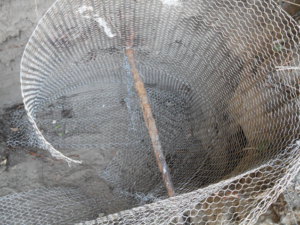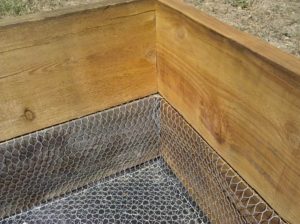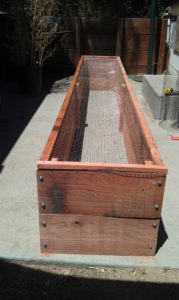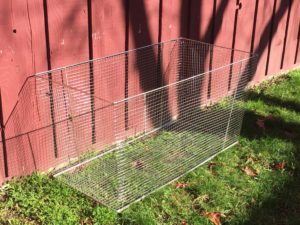How to Protect Your “Victory” Garden from Hungry Animals
In this time of “Shelter In Place” gardening is a great way to feel productive and grow food that you know has only been touched by you. Gardening is very therapeutic as well and can ease isolation as you get to know and taste the difference in fresh fruits and vegetables.
This has been the perfect spring for starting a garden with the current weather system of occasional rain with periods of dry times. There will be some competition to the health of your garden, however, from wildlife that are becoming bolder due to the lack of human outdoor activity, less noise pollution.
This article is about how to protect your garden without the use of poisons.
A FENCE IS THE BEST DEFENCE
There are many ways to protect your crop. If you are in gopher country the very best way is to fence them out. You can circle your garden with a vertical fence: an underground and above ground barrier that will stop almost all burrowing and surface problems. If you are going to make, or already have a deer fence to attach to, this kind of barrier will stop almost anything.
The barrier itself starts with getting some ¾ inch gopher wire (stainless steel is best) that is 48” wide and as long as needed, often sold in 100’ rolls. Dig a trench along the outside perimeter of your deer fence. Around 16” deep and 6” wide as close to the fence as you can. A 6” trenching shovel is best in most cases or rent a power trencher.
Lay your wire out and bend a 6” “L” at the bottom and place it into the trench with the bottom of the “L” facing away from your deer fence and bury the wire. This will use half of the 48” width of the wire.
Attach the wire to your deer fence using wire ties or “hog rings” leaving 6 inches free at the top. Then bend the free wire to the outside and if you are using stiff wire just let it stay sticking out. This will stop most climbing animals since getting over it will require an upside-down climb.
At any gate openings you will need to make a wood or paver threshold and be sure your gate fits right on it to keep any critters from squeezing underneath.
Alternately, I often will make a “U” turn shape with the wire right at the gate or any termination of the fence so the animal will get turned around and head back along the fence to the other “U” turn and so on.

PROTECT YOUR RAISED BED GARDEN
A very common way to protect your crop is to make raised garden beds using redwood or another wood resistant to rotting.
I recommend making the bed sides at least 12” high and installing a 2” x 6” seat around the top. This seat will not only make it easier to garden but also will prevent rodents from climbing over.
The bottom of the bed then needs protection from burrowing rodents like gophers, moles and rats. Again, I recommend using ¾” stainless gopher wire as it will outlast all other wires ensuring you will not have to remove all the soil and reline the bottom.
Attaching the wire is the most critical step. I have seen many failures due to inadequate fasteners, especially staples or U nails.
The wire must be sealed by sandwiching it between the side of the bed and another board or stiff item like steel or even PVC pipe drilled and screwed onto the bed.


Another alternative is a premade garden bed constructed again of stainless steel mesh measuring 2” x 4” and 18-24” high.

These premade units should be buried about a foot or so deep, leaving enough sticking out to become a barrier to animals traveling on the surface (gophers often invade this way).
These garden bed gopher baskets can also be used in sets of two. You can connect them so that one sits upside down on top of the other and can easily be hinged on 1 side for opening and closing. This will stop virtually all invading animals including birds and deer. As well, this setup can be a temporary greenhouse just by adding some plastic sheeting.
GOPHER BASKETS
Let’s also remember of course that protecting individual plants with “gopher baskets” is a very easy way to protect large and small plants. This is a must for large valuable fruit trees and perennials as well as large garden vegetables like tomatoes, melons and squash.
Baskets come in sizes that are like the black pots that are used for pre-grown plants in nurseries. Most often found in 1 gallon, 5 gallon and 15 gallon sizes.
- 1 gallon size is usually used for bulbs and small root systems
- 5 gallon size for mid sized plants like tomatoes
- 15 gallon size for trees and some large medicinal plants.
There are some other sizes available for extra-large plants and trees that are 34” in diameter and 18” deep and like I mentioned above, garden beds that are 2’ x 4’ and 18” deep.
I highly recommend finding stainless steel baskets made with heavy wire (18 Gauge with ¾“ mesh openings) as opposed to the finer stainless threads or galvanized baskets. The heavy stainless baskets will outlast other products by a huge amount.
The barriers described above are the best way I know of solving the frustrating problem of fighting pest animals already eating your crops. This will help you avoid the trauma of not only seeing your plant destroyed, but also the task of trapping.
Next Posts:
THE ART OF THE TRAP
DETERRENTS THAT CAN MOVE ANIMALS OUT OF YOUR GARDEN

